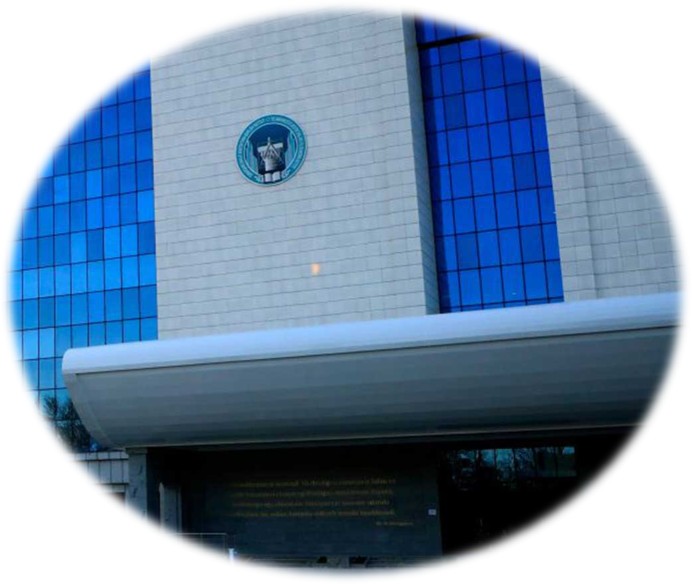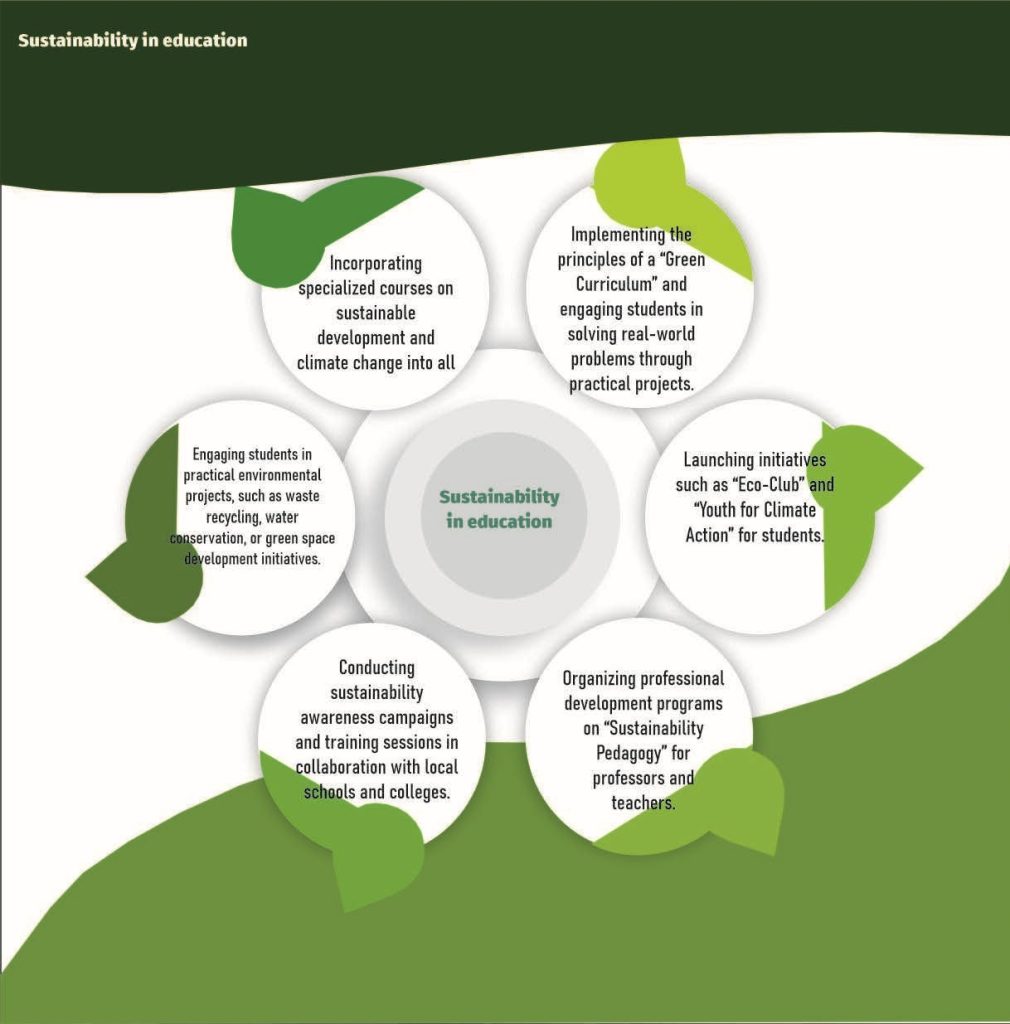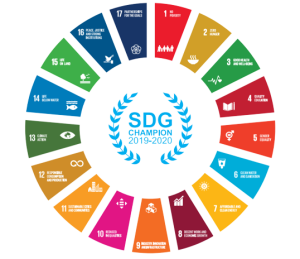Climate Change Strategy

1- The global and regional relevance of the climate change issue
2- Tasks facing Samarkand State University of Architecture and Construction
3- Sustainability 2030 Workplan
4- Sustainability in education
5- Sustainable scientific research
6- Sustainable living campuses
7- Collaboration and community engagement
8- Governance and monitoring
9 .Conclusion
9.1 Expected results
9.2 The long-term impact of the strategy and its contribution to sustainable development
The global and regional relevance of the climate change issue
Climate change today is one of the greatest global challenges facing humanity. Its consequences -heat waves, droughts, water scarcity, and the urban heat island effect – are particularly pronounced in Central Asia. In Samarkand city, summer heat, limited water resources, dust storms, and air quality problems pose serious obstacles to sustainable development. For Samarkand State University of Architecture and Construction, this issue is of particular importance. The construction and architecture sector is both one of the largest contributors to climate change a key field in mitigating its effects.
Through education and scientific research, the university is developing solutions such as energy-efficient buildings, low-carbon materials, green infrastructure, and climateresilient urban planning. Moreover, Samarkand’s rich historical heritage is highly sensitive to climate stresses, which is why SSUAC considers heritage preservation an integral part of its strategy. Overall, the university’s mission is to propose vital solutions in sustainable architecture and climate-resilient urban development, not only for the region but also for the world.
Rector of Samarkand State University of Architecture and Construction
Cidem Canbay Turkyilmaz
Doctor of Architecture, Professor

Dear colleagues, professors, and students,
Today, one of the most pressing global challenges facing humanity is climate change. The future of humanity and the well-being of our next generations depend on how responsibly we approach this issue.
The following priority tasks lie ahead of Samarkand State University of Architecture and Construction:
• Improving education towards sustainable development. Preparing our students to become environmentally responsible specialists by deeply integrating the principles of climate action into every field of study.
• Expanding innovative approaches in scientific research. Developing projects in construction, architecture, and urban planning that promote energy-efficient technologies, green architectural solutions, and the preservation of biodiversity.
• Strengthening international cooperation. Implementing joint programs with foreign universities and research centers aimed at mitigatin the consequences of climate change.
• Fostering ecological culture in university life. Promoting environmental responsibility among students and faculty, expanding green are s, ensuring waste recycling, and encouraging the rational use of resources.
Our primary goal is to harmonize scientific potential, the quality of education, and social responsibility to implement effective initiatives for a sustainable future.
Dear colleagues and students.Let us join forces to transform Samarkand State University of Architecture and Construction into a leading educational and scientific center in the fight against climate change.
In today’s era of globalization and climate change, sustainability has emerged as a key priority for all educational institutions. Universities and research centers are expected not only to provide knowledge but also to contribute to society by putting sustainability principles into practice. To achieve this, the Sustainability Workplan is based on three main directions:
Sustainable scientific research refers to conducting studies that have long-term outcomes, are environmentally and socially beneficial, and conser ve resources. This approach requires the deep integration of sustainability principles into the development of science.
By promoting sus amability in the education system, future generations are provided with sk ills that integrate environmental awareness, social responsibility, and economic efficiency. This involves not only theoretical knowledge but also a practical approach aimed at shaping a sustainable lifest le.
Introducing green echnologies on university and educational institution campuses, using renewable energy, reducing waste, and creating a healthy, eco-friendly environment for students. This direction envi sions applying sustainability not only as a theory but also as a practical wa of life.

Sustainable Scientific Research
Sustainable Scientific Research (Barqaror ilmiy tadqiqotlar)
Today, sustainable research plays an important role in addressing climate change, the rational use of resources, and solving environmental challenges. At Samarkand State University of Architecture and Construction, research in this field not only ensures scientific achievements but also contributes to regional and global sustainability through its practical application.Scientific developments are created based on innovative and sustainable solutions. These developments lead to the design of energy-efficient, environmentally safe, and economically effective technologies. Moreover, the outcomes of scientific research are implemented in practice, serving to address climate issues not only at the regional level but also on a global scale.As a result, ecological awareness in society rises, the principles of sustainable development are more widely applied, and a healthy environment for future generations is fostered.
Establishing a specialized scientific center on climate change, energy-efficient architecture, and green construction.
ChatGPT сказал: Supporting “Green Architecture” and “Climate Resilient Design” projects for students and professors.
Actively participating in international grants on green technologies, renewable energy, and sustainable materials.
Conducting research on “zero-energy buildings” and “eco-campus” projects adapted to local conditions.
Enhancing the university’s scientific potential through research articles, conferences, and international
Sustainable Living Campuses (Barqaror yashash kampuslari)
About Our Plan
It is planned to transform the university campus into a green, energy-efficient, and environmentally friendly space. In this process, special attention will be given to creating sustainable infrastructure, expanding green areas, and utilizing renewable energy sources.
How We Work
An environmentally safe campus will be created by reducing waste, efficiently using water and energy resources, and establishing a recycling system. Students and professors will have the opportunity to directly practice a sustainable lifestyle, thereby shaping a culture of sustainability and actively contributing to its dissemination throughout society.
The university campus will be transformed into a green, energy-efficient, and environmentally friendly space.
Waste reduction and the efficient use of water and energy resources will be implemented on campus.
Students will learn to directly apply a sustainable lifestyle in their daily lives.
COOPERATION
Local Partnerships
- Implementation of “green city” and “sustainable transport” projects with city authorities and government agencies.
- Environmental awareness campaigns, waste recycling and greening campaigns with the community and the public.
National Collaboration
- Joint scientific research with Uzbek universities and the “Sustainable Campuses” initiative.
- Information and advocacy work on sustainability with national media.
International Cooperation
- Cooperation with international organizations such as UNESCO, UNEP, GreenMetric, UNDP.
- Joint scientific research and exchange programs with foreign universities (student/faculty exchange).
- Organization of international conferences, forums and “summer schools” on SDGs.
MONITORING AND ASSESSMENT
Governance mechanisms
SDGs Sustainability Committee: A special council will be established, consisting of the university leadership, faculty deans, student representatives, and partner organizations.
Responsible units: Each faculty and center will develop and implement projects aligned with the SDGs.
Collaboration coordination: A dedicated coordination unit will operate to strengthen partnerships with local, national, and international organizations.
Monitoring and evaluation
Annual reports: The university will prepare an open report each year on the results achieved in relation to the SDGs.
Indicator system: Clear indicators will be
developed, such as waste reduction, energy efficiency, number of scientific publications, anc collaborative projects.
External evaluation: Improvement efforts will be carried out based on assessments by international rankings and independent organizations.
Dissemination of results
Open platform: An “SDGs Progress Dashboard” will be created on the university website to present all results to the public.
Events: Regular seminars, roundtable discussions, and forums on the SDGs will be organized.
Student participation: By involving students in the monitoring process, their leadership and responsibility skills will be developed.

Conclusion
Within the framework of the SamDAQU -Climate Action 2030 Workplan (2025-2030) the strategies developed will further strengthen the university’s contribution to sustainable development.
This plan identifies the development of sustainable scientific research, the promotion of sustainability in education, and the creation of a green, energy-efficient campus as key priorities. Through local, national, and international cooperation systems, opportunities will expand to achieve the SDGs, mitigate the impacts of climate change, and develop new innovative solutions.
The introduction of monitoring and governance mechanisms will enhance effectiveness, ensure transparency and openness in processes, and reinforce the university’s international reputation.
Overall, this Workplan serves as a roadmap for sustainable development not only for the university but also for the wider community, partner organizations, and students, ensuring Samarkand State University of Architecture and Construction plays a leading role in combating climate change.

Expected Results
In the scientific field: Innovative and sustainable solutions-
based research developments will be created, serving to address regional and global climate challenges.
In the education system: A culture of sustainability will be
fostered among students and professors, with new curricula and training programs introduced.
On campus: A green, energy-efficient, and environmentally safe environment will be established, with systems for waste reduction and rational resource use implemented.
In collaboration: Joint projects with local, national, and
international organizations will be carried out, enhancing the university’s position in international rankings.
For students: Social responsibility, environmental awareness, and leadership skills will be strengthened.
Barqaror rivojlanishga qo’shadigan hissa
Climate change adaptation: The university’s scientific developments will help reduce environmental risks and enhance resilience.
Environmental sustainability: Recycling, energy and water
conservation will minimize negative impacts on the environment.
Social sustainability. Sustainability values will be widely promoted among students, the community, and partners.
Economic sustainability: Energy-efficient technologies and innovative solutions will reduce costs and increase efficiency.
Global contribution: Through projects aligned with the SDGs, contributions will be made to sustainable development not only in Uzbekistan but also internationally.

